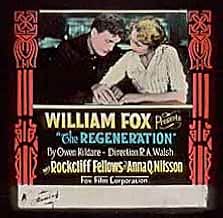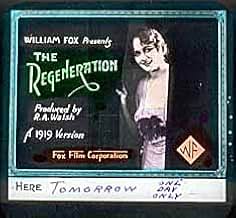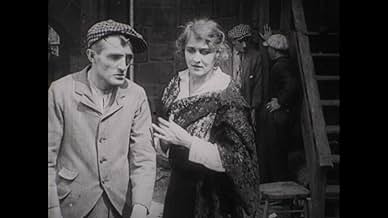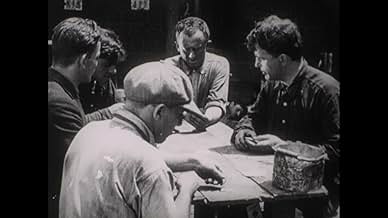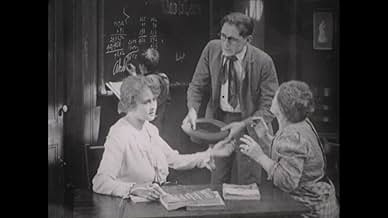VALUTAZIONE IMDb
6,8/10
1521
LA TUA VALUTAZIONE
Aggiungi una trama nella tua linguaA boy surrounded by violence grows up to become an infamous gangster.A boy surrounded by violence grows up to become an infamous gangster.A boy surrounded by violence grows up to become an infamous gangster.
- Regia
- Sceneggiatura
- Star
- Premi
- 1 vittoria in totale
James A. Marcus
- Jim Conway
- (as James Marcus)
Harry McCoy
- Owen - Age 17
- (as H. McCoy)
Peggy Barn
- Woman
- (non citato nei titoli originali)
William Dyer
- Drunk Friend of Jim Conway
- (non citato nei titoli originali)
Recensioni in evidenza
Raoul Walsh had been an actor and an understudy assistant director under D. W. Griffith when Fox Films hired him to direct his first feature film, September 1915's "Regeneration." Many cite Walsh's full-length directorial debut as cinema's first gangster feature film.
Walsh had run away from home at 15 and worked a series of laborious, dangerous jobs, including a cow hand and a seafarer. His hands at that time were so calloused he refused to shake hands. Because of his horse-riding skills, D. W. Griffith hired him as an actor, with one of his first roles as a young version of Mexican revolutionist Pancho Villa.
Walsh showed enough of a curiosity of filmmaking that Griffith took him on as an assistant director, most notably helping him out in "The Birth of a Nation." In the 1915 film, Walsh also plays John Wilkes Booth, who kills Abraham Lincoln. Newly formed Fox Films Corporation heard and saw so many good things from Walsh that William Fox hired him to do one of his studio's first feature films.
"Regeneration," adapted from a 1908 play based on Owen Kildare's autobiography, was a redemption tale of a boy who grew up to become a criminal, but eventually realizing the wrongs he had committed through the guiding influence of a female social worker. Walsh decided to film in New York City's poor Lower East Side using actual criminals and prostitutes to heighten his movie's authenticity.
Elements of Griffith, who Walsh labeled as his teacher, is clearly visible in "Regeneration:" the masking of the lens, the parallel editing and camera positioning, numerous close ups and implementing newly devised cinematic techniques such as a handful of dolly movements. Certain scenes Walsh filmed contained chiaroscuro lighting, anticipating Germanic Expressionism film aesthetics by a few years.
Walsh would become one of Hollywood's auteurs noted for his hard-hitting, macho crime movies such as 1939's "The Roaring Twenties," 1941 "High Sierra," and 1949's "White Heat." He would direct until his final film in 1964, and have a script of his produced as a movie in 1970.
Walsh had run away from home at 15 and worked a series of laborious, dangerous jobs, including a cow hand and a seafarer. His hands at that time were so calloused he refused to shake hands. Because of his horse-riding skills, D. W. Griffith hired him as an actor, with one of his first roles as a young version of Mexican revolutionist Pancho Villa.
Walsh showed enough of a curiosity of filmmaking that Griffith took him on as an assistant director, most notably helping him out in "The Birth of a Nation." In the 1915 film, Walsh also plays John Wilkes Booth, who kills Abraham Lincoln. Newly formed Fox Films Corporation heard and saw so many good things from Walsh that William Fox hired him to do one of his studio's first feature films.
"Regeneration," adapted from a 1908 play based on Owen Kildare's autobiography, was a redemption tale of a boy who grew up to become a criminal, but eventually realizing the wrongs he had committed through the guiding influence of a female social worker. Walsh decided to film in New York City's poor Lower East Side using actual criminals and prostitutes to heighten his movie's authenticity.
Elements of Griffith, who Walsh labeled as his teacher, is clearly visible in "Regeneration:" the masking of the lens, the parallel editing and camera positioning, numerous close ups and implementing newly devised cinematic techniques such as a handful of dolly movements. Certain scenes Walsh filmed contained chiaroscuro lighting, anticipating Germanic Expressionism film aesthetics by a few years.
Walsh would become one of Hollywood's auteurs noted for his hard-hitting, macho crime movies such as 1939's "The Roaring Twenties," 1941 "High Sierra," and 1949's "White Heat." He would direct until his final film in 1964, and have a script of his produced as a movie in 1970.
Raoul Walsh had just come off _The Birth of a Nation_ both as one of Griffith's assistant directors and as an actor (most prominently as John Wilkes Booth), when he made this film. In his autobiography, Walsh credits Griffith with "teaching" him not only about much of the art of fiction filmmaking, but also about production management technics that aided him in taking full advantage of many of New York City's most pictorial exterior locations.
The locations play an important role in adding to the naturalism of an otherwise highly melodramatic plot with the high society young woman turned heroine social worker (much overplayed by a major star of the 1910s, Anna Q Nilsson) and the regeneration of the one-time Lower Manhatan gang leader.
The wonder of this film is the performance of the male "star", Rockliffe Fellowes, who played in over a dozen nearly unremembered films until he died in 1950. His performance is so subtly varied and electrically alive that one is reminded of Brando in his early 1950s films. An interesting sidenote about his performance: The movieola film editing machine -- that magnified the small 35mm frame to about 4 inches by 6 inches as it ran the film stock through the viewer at the proper projection speed -- was not invented until much later. In 1915, editors had to hold the footage up to the light to see each frame and/or use a magnifying glass; but they could not also run the film at speed at the same time. Hence, many of the subtlest nuances that cross the hero's face could not be clearly seen and judged in editing: _Regeneration's_ editor often cuts away before the movement has settled, or cuts into a close or medium shot of the hero after the nuance has already begun.
Watching the film on a large screen today, one is aware how powerful present-day editing technics are at capturing all such movements in the hands of a skilled editor. In _Regeneration_ there is a distinct feeling of rough editing at the moments we leave or cut to the hero at the "wrong" instant. By the way, the original title was NOT _The Regeneration_, but _Regeneration_ alone. From which we can surmise that Walsh was looking to create a work with universal meaning.
The locations play an important role in adding to the naturalism of an otherwise highly melodramatic plot with the high society young woman turned heroine social worker (much overplayed by a major star of the 1910s, Anna Q Nilsson) and the regeneration of the one-time Lower Manhatan gang leader.
The wonder of this film is the performance of the male "star", Rockliffe Fellowes, who played in over a dozen nearly unremembered films until he died in 1950. His performance is so subtly varied and electrically alive that one is reminded of Brando in his early 1950s films. An interesting sidenote about his performance: The movieola film editing machine -- that magnified the small 35mm frame to about 4 inches by 6 inches as it ran the film stock through the viewer at the proper projection speed -- was not invented until much later. In 1915, editors had to hold the footage up to the light to see each frame and/or use a magnifying glass; but they could not also run the film at speed at the same time. Hence, many of the subtlest nuances that cross the hero's face could not be clearly seen and judged in editing: _Regeneration's_ editor often cuts away before the movement has settled, or cuts into a close or medium shot of the hero after the nuance has already begun.
Watching the film on a large screen today, one is aware how powerful present-day editing technics are at capturing all such movements in the hands of a skilled editor. In _Regeneration_ there is a distinct feeling of rough editing at the moments we leave or cut to the hero at the "wrong" instant. By the way, the original title was NOT _The Regeneration_, but _Regeneration_ alone. From which we can surmise that Walsh was looking to create a work with universal meaning.
Raoul Walsh, aged 28, has already done it all : he's been a Cow-boy, an actor, and Griffith's assistant for BIRTH OF A NATION, in witch he also played Lincoln's murderer. That's certainly why his very first movies, as this "Regeneration", are already so mastered and so mature. The story of the movie is quite simple : it tells us the life of a gang leader : Owen, from his unhappy childhood to his "regeneration", thanks to Mary, a young lady, who believed in his kindness, and allows him a second chance. But beyond this classical story, this movie is both a brilliant example of Griffith's omnipotent influence on early American cinema and also a totally original and new form of cinema, for it invents the codes of the Gangster's movie and of the "Film Noir" for the years to come.
As in a Griffith's feature, the ideas of the movie are developed thanks to an original use of the editing. For instance, at the beginning of the movie, Walsh superposes a frame of Owen adult, drinking a beer, with one of the same character as a child, eating an ice cream in the exact same position. This editing has of course a narrative function it reminds us that Owen is the same character of the beginning of the movie, only few years after but it also presents him, whereas he could appears as a dangerous criminal, as the same innocent victim that he was younger. This king of narrative and yet symbolist use of the editing is both a homage to Griffith and an introduction to Walsh'own style and thematic.
Griffith's influence is also very strong in the movie's will to be spectacular. When Walsh wants to show how Owen tries to change in the contact of Mary, he creates for instance a gigantic fire on a boat, where Owen risks his life saving children. Of course, we're not really in the bigger than life world of INTOLERANCE or of BIRTH OF A NATION, but still, it's the same spectacular idea of the cinema that Walsh and Griffith share. In 1915, Raoul Walsh is certainly still in the shadow of Griffith, but "Regeneration" is a lot more than a copy of Griffith's cinema, and can be fully appreciates without its relation to its style.
The movie is particularly realistic and has nothing to see with Griffith traditional romanticism. It's the adaptation of an ex-criminal autobiography, and Walsh is really good in showing sordid and realistic details, especially in the description of Owen's terrible childhood. The movie is surprisingly strong, violent and realistic for its age. But Walsh also adds to this realistically point of view, a sort or mythification of his Gangster's character, who almost become an icon, witch we'll find again in the all American Cinema to come, from Hawks 's SCARFACE, to Scorsese's movies. Fiction is already torn between realism and myth, and a large part of Walsh's Cinema will develops this thematic, as in his absolute masterpiece : THEY DIED WITH THEIR BOOTS ON.
The realism of the movie even goes with the myth, for it's mostly in the realistically description of a gangster's everyday life that the "Film Noir" will takes its future codes. Owen and his gang spend most of their time doing nothing : they walk on the docks, in the streets or drinks in clubs, but we almost never see them in action. Or when we do, we see them doing good things, for action time is in the movie regeneration time. Morality is in Walsh'Cinema a rhythm question. Inaction and immobility stuck to the Gangster's life, whereas action and movements is associated to honesty and to the opportunity to grab a good life.
That's how « Regeneration » always seems to be torn between external (Griffith/Walsh) and internal (realism/myth) conflicts, that are the extension of Owen's inner fights between a honest's life and a gangster's one, between the soft world of Mary, and the harsh and masculine one of the Gang. The end of the movie literally destroys this psychological conflict, when the two characters that symbolized each side both died. After having destroyed the two conflicted sides of his personality, Owen's life can really begins, as well as Walsh's cinema.
As in a Griffith's feature, the ideas of the movie are developed thanks to an original use of the editing. For instance, at the beginning of the movie, Walsh superposes a frame of Owen adult, drinking a beer, with one of the same character as a child, eating an ice cream in the exact same position. This editing has of course a narrative function it reminds us that Owen is the same character of the beginning of the movie, only few years after but it also presents him, whereas he could appears as a dangerous criminal, as the same innocent victim that he was younger. This king of narrative and yet symbolist use of the editing is both a homage to Griffith and an introduction to Walsh'own style and thematic.
Griffith's influence is also very strong in the movie's will to be spectacular. When Walsh wants to show how Owen tries to change in the contact of Mary, he creates for instance a gigantic fire on a boat, where Owen risks his life saving children. Of course, we're not really in the bigger than life world of INTOLERANCE or of BIRTH OF A NATION, but still, it's the same spectacular idea of the cinema that Walsh and Griffith share. In 1915, Raoul Walsh is certainly still in the shadow of Griffith, but "Regeneration" is a lot more than a copy of Griffith's cinema, and can be fully appreciates without its relation to its style.
The movie is particularly realistic and has nothing to see with Griffith traditional romanticism. It's the adaptation of an ex-criminal autobiography, and Walsh is really good in showing sordid and realistic details, especially in the description of Owen's terrible childhood. The movie is surprisingly strong, violent and realistic for its age. But Walsh also adds to this realistically point of view, a sort or mythification of his Gangster's character, who almost become an icon, witch we'll find again in the all American Cinema to come, from Hawks 's SCARFACE, to Scorsese's movies. Fiction is already torn between realism and myth, and a large part of Walsh's Cinema will develops this thematic, as in his absolute masterpiece : THEY DIED WITH THEIR BOOTS ON.
The realism of the movie even goes with the myth, for it's mostly in the realistically description of a gangster's everyday life that the "Film Noir" will takes its future codes. Owen and his gang spend most of their time doing nothing : they walk on the docks, in the streets or drinks in clubs, but we almost never see them in action. Or when we do, we see them doing good things, for action time is in the movie regeneration time. Morality is in Walsh'Cinema a rhythm question. Inaction and immobility stuck to the Gangster's life, whereas action and movements is associated to honesty and to the opportunity to grab a good life.
That's how « Regeneration » always seems to be torn between external (Griffith/Walsh) and internal (realism/myth) conflicts, that are the extension of Owen's inner fights between a honest's life and a gangster's one, between the soft world of Mary, and the harsh and masculine one of the Gang. The end of the movie literally destroys this psychological conflict, when the two characters that symbolized each side both died. After having destroyed the two conflicted sides of his personality, Owen's life can really begins, as well as Walsh's cinema.
People who think that all silents are sticky with Victorian melodrama will be surprised by the sustained pace, the bracing realism, and the soft-pedaling of the sentimental elements of this startlingly fresh film. The 28-year old Raoul Walsh had already written and produced a dozen films when he directed this. Although the narrative rambles a bit, Walsh's dynamic use of film grammar - closeups, dollies in and out, cross-cutting between scenes, sharp editing - makes REGENERATION look more modern than many silent films made ten years later. Walsh shows his creativity when he uses the circling movements of dancers to foreshadow public panic in an impressively staged sequence of a fire [although it has little plot function]. Titles are used sparingly throughout, and even they are terse and direct. The performances are also surprisingly natural, from square-jawed Rockcliffe Fellowes [who looks something like Robert Stack] to Anna Q. Nilsson, who gives a delicate, sympathetic performance as the good girl/settlement worker. Within the outline of a traditional melodrama, Walsh forthrightly portrays the underside of contemporary society, keeps the sentiment light, and provides an ending that is not without surprises either.
By the standards of its time, this is a better than average film, and it is still watchable, even though the social and cinematic conventions of 1915 may make it rather quaint to some viewers. Still, the theme about a good woman regenerating a rascal is not unusual today, and here it is told with coherence and simplicity.
One may find the acting style quaint, too, but some of the worst excesses of the silent days are avoided for the most part. Perhaps we can thank young Raoul for that. The editing is choppy, but that may be due to losses over the years, and it may vary depending on the print or tape translation one sees.
One may find the acting style quaint, too, but some of the worst excesses of the silent days are avoided for the most part. Perhaps we can thank young Raoul for that. The editing is choppy, but that may be due to losses over the years, and it may vary depending on the print or tape translation one sees.
Lo sapevi?
- QuizMost of the extras in this film were real locals from the Bowery area, as well as from Hell's Kitchen, and had never appeared before in films. Most of the gangster characters were actual gangsters in real life.
- Citazioni
District Attorney Ames: Very fine and loyal, my boy, but you can't save your friend, and you have lost whatever chance you had - with her.
- Curiosità sui creditiThere is no cast list during the opening credits or at the end. Actors, however, are credited by intertitles as they appear within the movie, and that is used for the IMDb cast ordering. Actors never mentioned are marked uncredited.
- Versioni alternativeKino International released a version which runs 72 minutes and contains an uncredited piano score.
I più visti
Accedi per valutare e creare un elenco di titoli salvati per ottenere consigli personalizzati
Dettagli
- Data di uscita
- Paese di origine
- Lingua
- Celebre anche come
- The Regeneration
- Luoghi delle riprese
- Hudson River, Nyack, New York, Stati Uniti(burning of the excursion barge)
- Azienda produttrice
- Vedi altri crediti dell’azienda su IMDbPro
- Tempo di esecuzione
- 1h 12min(72 min)
- Colore
- Mix di suoni
- Proporzioni
- 1.33 : 1
Contribuisci a questa pagina
Suggerisci una modifica o aggiungi i contenuti mancanti

